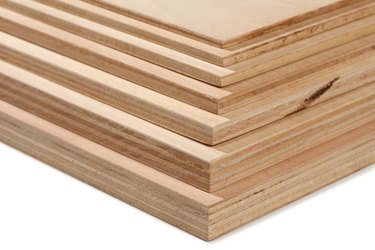
Changes in temperature can have a profound effect on building materials, and although plywood doesn't react as dramatically to extreme temperatures as some other materials do, its thermal properties can help determine what construction roles it's best suited to play. Plywood's thermal properties also figure into the home's insulation calculations when using it as exterior sheathing and subfloor materials.
Thermal Conductivity
Video of the Day
A material's thermal conductivity is its ability to transmit heat from one side of the material to the other. Thermal conductivity is presented as a K-value, and the higher this value is, the better able it is to conduct heat. Conductivity can be an issue in situations such as the installation of an underfloor hydronic heating system, where you want the flooring to conduct heat. Plywood typically has a K-value of 1 or less, while ceramic tile, for example, has a K-value of about 12.5. Tile is clearly the better choice for installation above an in-floor heating system with the plywood subfloor beneath the hydronic tubing.
Video of the Day
Thermal Expansion
Almost all solid substances expand when they get hot and contract when they get cold, but compared to substances such as most metals, wood expands very little when the temperature increases. Thermal expansion doesn't have much of an effect on plywood; it expands minimally per inch of the panel's length for every one degree Fahrenheit of temperature increase, and that's only when the majority of the panel's plies have grain that's perpendicular to the panel surface. Plywood expands much more when it's exposed to moisture, so thermal expansion in itself is only a concern when construction tolerances are extremely tight and the moisture content of the wood is precisely controlled.
Thermal Resistance
Thermal resistance is the material's ability to resist the transmission of heat, the inverse of its thermal conductivity -- the better a material's thermal resistance, the more stable the temperature difference on either side of the material. Thermal resistance is indicated as an R-value; materials with high R-values are better insulators than those with low values. Fiberglass batt insulation, for example, typically has an R value greater than 3 per inch of thickness; a 1-inch-thick plywood panel has an R-value of about 1.25, so it's a significantly less efficient insulator and isn't enough, by itself, to adequately insulate exterior walls.
Thermal Degradation
Exposure to high temperatures causes plywood to degrade and lose structural strength. Strength loss caused by temperatures between 70 and 200 degrees Fahrenheit is temporary, and the loss will be recovered when the temperature is reduced. Temperatures above 200 degrees will likely cause permanent damage. Such high temperatures are rarely encountered in residential construction, but they may be an issue when plywood is used as roof sheathing in warm climates.